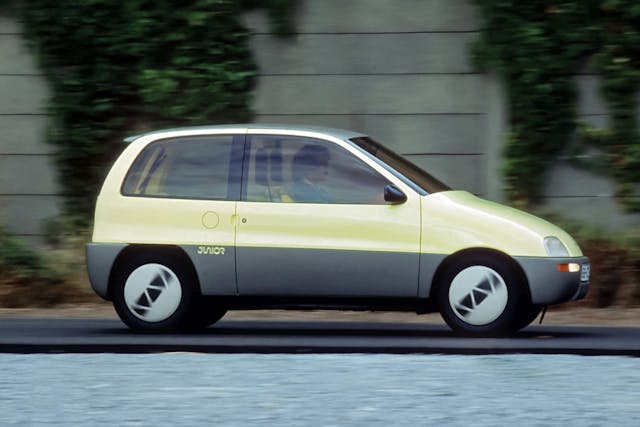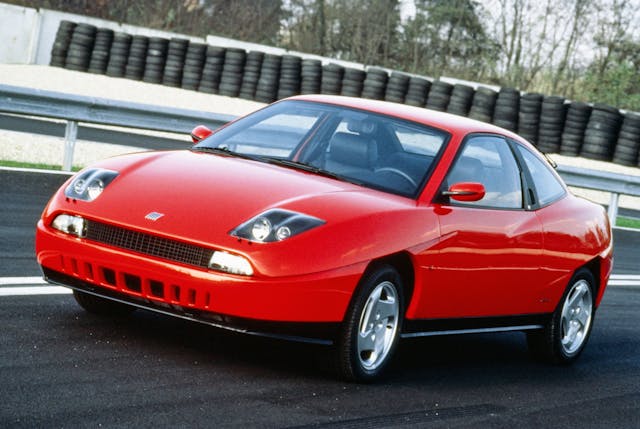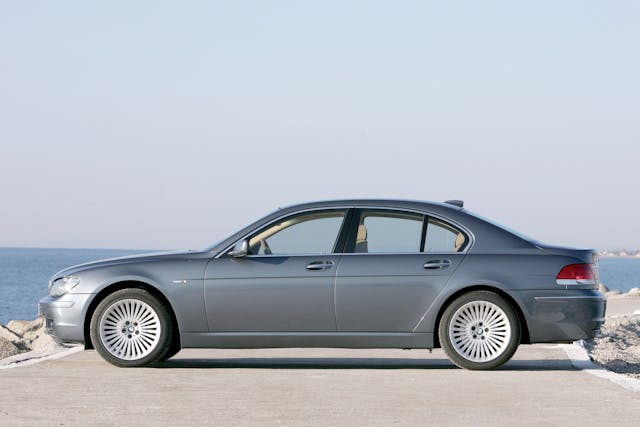When it comes to the court of public opinion, for many the jury is still out on American car designer Chris Bangle. Born in 1956, Bangle was raised in Wisconsin and chose car design over a career as a methodist minister. After moving to Europe in 1981, he landed a role as a junior designer at Opel. He then joined the design team at Fiat in 1985, before being recruited as BMW’s design chief in late 1992, where he remained until he left the car industry altogether in 2009 to focus on other areas of product design, most recently in consumer electronics.
Although he was never the head of design for any manufacturer, a few cars reached showrooms or motor show turntables looking pretty much exactly as he envisioned them. His Fiat and Alfa Romeo projects were instant hits, but was his flame-sided BMW surfacing project a difficult third album? Even now, his designs divide opinion. These five cars are his best-known standalone designs.
1983 Opel Junior
 Opel
Opel
Although it never saw production, in some ways the Opel Junior was Bangle’s most cohesive design.
It was unveiled at the 1983 Frankfurt Motor Show as a small city car, designed to provide transport for four people in as small a footprint as possible—a concept similar to that of the original Austin-Morris Mini.
It meant the car had to be tall, but to maintain efficiency from its frugal 1.2-liter engine, Bangle made sure it was as aerodynamic as possible, with flush glazing and lamp units. While it looked quite different, a lot of the aerodynamic surfacing found its way onto the 1993 Opel Corsa B, which ushered in a new world of roundness to European small-car market. The Junior had a drag coefficient of 0.31, which was astonishing for such a small and tall machine.
In addition, there was a focus on cost; the cabin and dash were created in a way that would be much easier to build with either left- or right-hand drive, with many of the core controls located centrally.
1994–2000 Alfa Romeo 145
 Stellantis
Stellantis
Alfa Romeo has never been a brand known for doing things conventionally, so it was no surprise to find that the 145 looked completely different from anything else in its class when it debuted in 1995—two-and-a-bit years after Chris Bangle had left Fiat Group, but still very much his creation.
The bold “bread van” profile was enhanced with a wraparound glass area at the rear, giving it a side view unlike anything else seen on its its mid-size rivals from other manufacturers.
Some found it challenging, others loved it, but in time the 145’s styling has certainly mellowed. It’s a distinctive and handsome machine, with a beaked nose that set the design language for an entire generation of Alfas to follow.
1993–2000 Fiat Coupé
 Fiat
Fiat
Officially known as the Coupé Fiat, but more commonly known by the reverse, the striking two-door was revealed at the 1993 Bologna Motor Show, shortly after Bangle’s departure to BMW.
It was an incredible car, with Bangle’s bold exterior enhanced by a Pininfarina-penned interior that was equally breathtaking. Its distinctive side strakes were perhaps a hint at what was to come from the American designer, who wasn’t afraid to challenge convention with a car’s side appearance. Sold alongside the Alfa Romeo GTV, with which it shared quite a few common components, it was a daring and edgy design that has stood the test of time.
2001–2008 BMW 7 Series
 BMW
BMW
Perhaps Chris Bangle’s most controversial design, the E65 BMW 7 Series certainly defied convention.
It likely didn’t help that the E38 7 Series it replaced was arguably one of the most handsome large cars ever made, nor that the executive sedan market was traditionally one of the most conservative areas of the car industry. So, when Bangle’s 7 appeared, the car was met with a level of consternation that it never really shook off. The rear end also earned the derisive “Bangle Butt” moniker. (That iDrive also debuted in this machine probably didn’t help things, either.) But even when a more rounded facelift came along in late 2006, there were still grumbles.
Its unusual grille and odd-shaped headlights, incorporating the indicators above the lamp lenses, didn’t really help, nor did its rotund rump, but it was the flame-sided profile that attracted the most criticism. It was said to lack harmony and received a controversial reception in the media.
In time, it has mellowed. Today, you can look at an E65 among a sea of more modern designs, and it somehow feels a lot more congruous than it did in 2001. But it certainly divided opinion when new, and the flame-sided effect was toned-down for future BMW sedans.
2003–08 BMW Z4
 BMW
BMW
Undeterred by the rather stark reception received by the 7 Series, Bangle applied the flame surfacing theory with equal power on the replacement for the Z3; a car that had already caused a stir when it first appeared in 1995 for looking so different from any BMW before it.
There were echoes of the E65 in the Z4’s styling, with a similar headlamp arrangement, a vast curved hood, and distinctive side strakes, yet its execution in a sports car was wholly better received than it was in an executive sedan and proved that, in the right application, a bold, even daring approach to vehicle styling had its place.
Put side-by-side with the 7 Series, the family resemblance is clear, but it somehow works far here. Twenty-two years since it first appeared, the original Z4 still looks fresh and modern.

